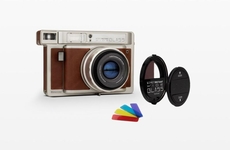
The Moment 3D Camera by Olga Orel Captures Scenes from Four Lenses
Michael Hemsworth — December 7, 2023 — Tech
References: yankodesign
The conceptual Moment 3D Camera has been designed by Olga Orel as a modern piece of photography equipment that takes digital culture into account to support modern consumer preferences.
The camera is characterized by its compact construction that uses four 38mm lenses to capture scenes from four different angles. This enables the camera to create GIFs right on the device that are ready for sharing on social media and more. The camera is equipped with a large display on the rear that's flanked by buttons for navigating the interface and making changes. The hardware identifies how photography equipment can be engineered to suit the preferences of digital natives.
Orel spoke further on the inspiration behind the conceptual Moment 3D Camera saying, "I discovered old cameras such as Nishika N8000 and Nimslo from the 1980s made by various companies with the same idea of stereography. They were quadrascopic (four lenses) cameras designed to produce four half-frame images from a click of the shutters. Lenticular prints could be made from the negatives. Unfortunately, the demand for these products was low due to people losing interest while waiting for the prints, which could take weeks and by some accounts, months to return to the consumer. You have to understand, these cameras were introduced BEFORE we knew anything about GIFs or JPEG files!”
The camera is characterized by its compact construction that uses four 38mm lenses to capture scenes from four different angles. This enables the camera to create GIFs right on the device that are ready for sharing on social media and more. The camera is equipped with a large display on the rear that's flanked by buttons for navigating the interface and making changes. The hardware identifies how photography equipment can be engineered to suit the preferences of digital natives.
Orel spoke further on the inspiration behind the conceptual Moment 3D Camera saying, "I discovered old cameras such as Nishika N8000 and Nimslo from the 1980s made by various companies with the same idea of stereography. They were quadrascopic (four lenses) cameras designed to produce four half-frame images from a click of the shutters. Lenticular prints could be made from the negatives. Unfortunately, the demand for these products was low due to people losing interest while waiting for the prints, which could take weeks and by some accounts, months to return to the consumer. You have to understand, these cameras were introduced BEFORE we knew anything about GIFs or JPEG files!”
Trend Themes
1. Compact Construction - The Moment 3D Camera's compact construction using four lenses offers an opportunity for disruption in the photography industry.
2. GIF Creation - The ability of the Moment 3D Camera to create GIFs right on the device presents a disruptive innovation opportunity for the photography market.
3. Digital Native Preferences - The engineering of the Moment 3D Camera to suit the preferences of digital natives highlights a potential disruptive innovation opportunity in the photography equipment sector.
Industry Implications
1. Photography Equipment - The Moment 3D Camera introduces disruptive innovation opportunities within the photography equipment industry with its compact construction and GIF creation capabilities.
2. Social Media - The Moment 3D Camera's ability to create ready-to-share GIFs aligns with the demand for engaging content on social media, presenting a disruptive innovation opportunity within that sector.
3. Digital Culture - The Moment 3D Camera's incorporation of digital culture and catering to the preferences of digital natives showcases a disruptive innovation opportunity within the broader digital culture industry.
7.9
Score
Popularity
Activity
Freshness























